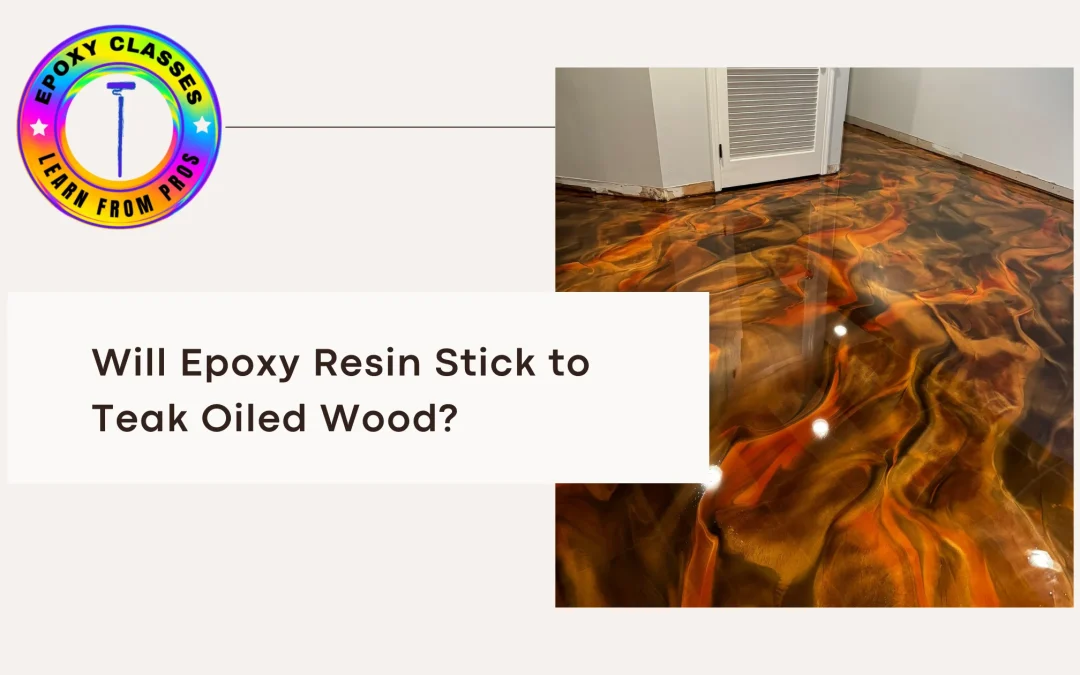When working on wood projects, especially with teak, a common question arises: Will epoxy resin stick to oiled teak? It depends on several factors. They include the type of oil used and the surface preparation.
Gluing teak or using epoxy resin on oiled wood requires care. You must check the type of finish. Let’s look at if epoxy resin can stick to tung-oiled and teak-oiled wood. It will also cover how to ensure a strong bond.
Learn epoxy techniques and product choices for various surfaces. Use Epoxy Classes NY to master perfect resin applications!
Can You Apply Epoxy Resin on Oiled Wood?
Oily finishes protect the wood and repel adhesives like epoxy. However, CPES epoxy resin, despite its strength, fails on teak-oiled surfaces. The barrier from oils, such as teak oil, prevents good bonding. Epoxy cannot penetrate this oily shield, leading to weak adhesion. Thus, strong, lasting bonds are impossible with epoxy on oil-treated wood.
Will Epoxy Resin Stick to Tung Oiled Wood?
Tung oil, like teak oil, forms a smooth, water-resistant layer on wood. This layer makes it hard for epoxy resin to stick. The slick surface needs careful prep work. First, you must remove or reduce the oil finish to apply epoxy on tung-treated wood. Skipping this step will cause poor adhesion and ruin the project.
How to Prepare Teak Oiled Wood for Epoxy Resin
Proper surface preparation is crucial. It ensures good adhesion between epoxy resin and teak finish wood.
- Clean the Surface: Wash the wood with mild soap to remove dirt and oil. Then, let it dry completely.
- Remove the Oil Finish: Epoxy resin needs bare wood to bond well. Teak oil coatings block this, so they must be removed. Use wood strippers or fine-grit sandpaper for this. This step is crucial for a strong bond between epoxy and wood.
- Let the Wood Dry: Before using epoxy resin, make sure wood surfaces are dry, especially after cleaners. Teak oil needs 24-48 hours to dry. If unsure, test with a small resin drop on a scrap piece. This ensures good bonding and project success.
- Apply Epoxy Resin: First, clean the wood and remove any oil. Then, apply epoxy resin. Follow the manufacturer’s instructions carefully. This ensures the best results and a perfect finish.
How Long for Teak Oil to Dry?
Let teak oil dry completely before applying epoxy resin. This takes 24-48 hours, depending on the climate. A dry surface ensures good adhesion. Rushing can cause problems, so be patient. Always check for dryness before applying resin.
Does Teak Oil Go Bad?
Teak oil doesn’t last forever. It can spoil if exposed to air or stored badly. Signs of spoilage are thickening and stickiness. This bad oil won’t protect wood properly. Heat or long storage can reduce its drying ability. Always check the oil first. Odd smells or consistency mean it’s time to replace it. Staying alert keeps wood safe and furniture beautiful.
Safe Use of Epoxy and Wood Finishes
For more on wood finishes and safe use of epoxy resin, visit the U.S. Consumer Product Safety Commission’s website. They offer valuable guidance on product safety and proper handling of chemicals.
Learn more here (U.S. Consumer Product Safety Commission).
This resource helps ensure safe and effective use of teak oil and epoxy resin in your projects.
Conclusion
In short, epoxy resin can struggle to stick to teak or tung oiled wood without proper prep. If you plan to use epoxy resin on teak finish wood, make sure to clean and remove any oil residue to ensure a strong bond. CPES epoxy resin can work well on prepped surfaces. But the wood must be clean, dry, and oil-free before use. By taking these steps, you can use epoxy resin in your wood projects. You won’t have to worry about poor adhesion.
FAQs
Will epoxy resin stick to teak oiled wood?
No, epoxy resin does not stick well to oiled teak wood without proper prep. The oil creates a barrier that prevents the resin from bonding effectively. It’s essential to remove the oil finish before applying epoxy resin.
What is the best way for gluing teak?
Before gluing, clean teak well to remove oils and finishes. This step ensures better glue or epoxy bonding. Stripped wood leads to a stronger connection. It’s vital for successful teak joinery.
How long for teak oil to dry?
Wait 24-48 hours for teak oil to dry. Drying time depends on the climate. Ensure the wood is fully dry before using epoxy or adhesives.
Does teak oil go bad?
Teak oil quality drops over time, especially if stored poorly. Signs of spoilage include thickness, stickiness, or a rancid smell. Replace the oil when you notice these signs for the best results.


